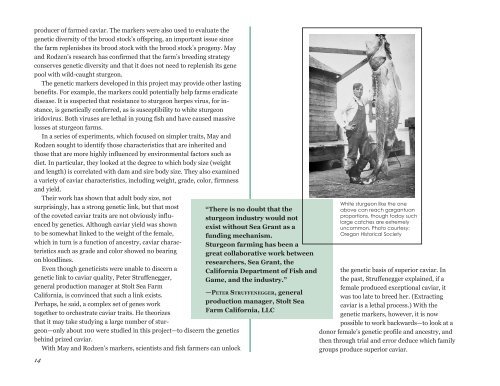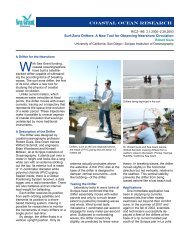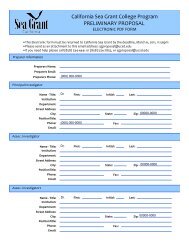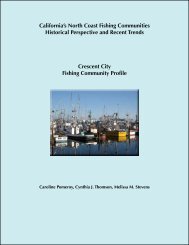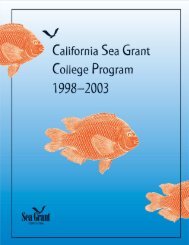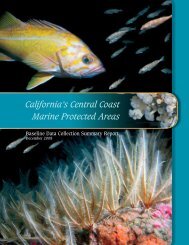2001â2002 - California Sea Grant - UC San Diego
2001â2002 - California Sea Grant - UC San Diego
2001â2002 - California Sea Grant - UC San Diego
Create successful ePaper yourself
Turn your PDF publications into a flip-book with our unique Google optimized e-Paper software.
producer of farmed caviar. The markers were also used to evaluate the<br />
genetic diversity of the brood stock’s offspring, an important issue since<br />
the farm replenishes its brood stock with the brood stock’s progeny. May<br />
and Rodzen’s research has confirmed that the farm’s breeding strategy<br />
conserves genetic diversity and that it does not need to replenish its gene<br />
pool with wild-caught sturgeon.<br />
The genetic markers developed in this project may provide other lasting<br />
benefits. For example, the markers could potentially help farms eradicate<br />
disease. It is suspected that resistance to sturgeon herpes virus, for instance,<br />
is genetically conferred, as is susceptibility to white sturgeon<br />
iridovirus. Both viruses are lethal in young fish and have caused massive<br />
losses at sturgeon farms.<br />
In a series of experiments, which focused on simpler traits, May and<br />
Rodzen sought to identify those characteristics that are inherited and<br />
those that are more highly influenced by environmental factors such as<br />
diet. In particular, they looked at the degree to which body size (weight<br />
and length) is correlated with dam and sire body size. They also examined<br />
a variety of caviar characteristics, including weight, grade, color, firmness<br />
and yield.<br />
Their work has shown that adult body size, not<br />
surprisingly, has a strong genetic link, but that most<br />
of the coveted caviar traits are not obviously influenced<br />
by genetics. Although caviar yield was shown<br />
to be somewhat linked to the weight of the female,<br />
which in turn is a function of ancestry, caviar characteristics<br />
such as grade and color showed no bearing<br />
on bloodlines.<br />
Even though geneticists were unable to discern a<br />
genetic link to caviar quality, Peter Struffenegger,<br />
general production manager at Stolt <strong>Sea</strong> Farm<br />
<strong>California</strong>, is convinced that such a link exists.<br />
Perhaps, he said, a complex set of genes work<br />
together to orchestrate caviar traits. He theorizes<br />
that it may take studying a large number of sturgeon—only<br />
about 100 were studied in this project—to discern the genetics<br />
behind prized caviar.<br />
With May and Rodzen’s markers, scientists and fish farmers can unlock<br />
14<br />
“There is no doubt that the<br />
sturgeon industry would not<br />
exist without <strong>Sea</strong> <strong>Grant</strong> as a<br />
funding mechanism.<br />
Sturgeon farming has been a<br />
great collaborative work between<br />
researchers, <strong>Sea</strong> <strong>Grant</strong>, the<br />
<strong>California</strong> Department of Fish and<br />
Game, and the industry.”<br />
—PETER STRUFFENEGGER, general<br />
production manager, Stolt <strong>Sea</strong><br />
Farm <strong>California</strong>, LLC<br />
White sturgeon like the one<br />
above can reach gargantuan<br />
proportions, though today such<br />
large catches are extremely<br />
uncommon. Photo courtesy:<br />
Oregon Historical Society<br />
the genetic basis of superior caviar. In<br />
the past, Struffenegger explained, if a<br />
female produced exceptional caviar, it<br />
was too late to breed her. (Extracting<br />
caviar is a lethal process.) With the<br />
genetic markers, however, it is now<br />
possible to work backwards—to look at a<br />
donor female’s genetic profile and ancestry, and<br />
then through trial and error deduce which family<br />
groups produce superior caviar.


